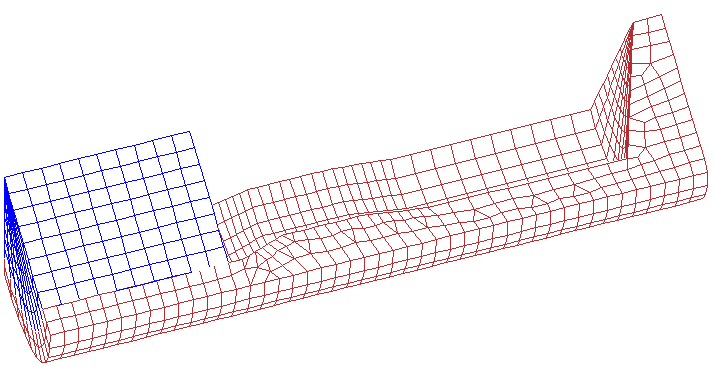8. F modeling#
8.1. Characteristics of modeling#
3D modeling (linear elements) is used.
The discrete contact formulation is used (active stress method).
Here we use the GLISSIERE function, which makes it possible to maintain contact throughout the extrusion, mathematically. The result is physically similar to modeling without a slide, since it is a frictionless extrusion.
8.2. Characteristics of the mesh#

Number of knots: 3292
Number of meshes: 2150 HEXA8, 260 PENTA6, 260, 1814 QUAD4 and 68 TRIA3
Number of nodes in contact: 210
8.3. Tested sizes and results#
The reference values are considered to be those of modeling C. The following displacement \(Y\) of the point \(K\) of the plot with respect to the surface \(\mathrm{ABCDEFG}\) of the die is tested.
Identification |
Reference type |
Reference value |
Tolerance |
Point \(K\)/Point \(B\) - \(\mathrm{DY}\) |
“ANALYTIQUE” |
5.0000 |
|
Point \(K\)/Point \(C\) - \(\mathrm{DY}\) |
“ANALYTIQUE” |
20.8250 |
|
Point \(K\)/Point \(D\) - \(\mathrm{DY}\) |
“ANALYTIQUE” |
55.8800 |
|
Point \(K\)/Point \(E\) - \(\mathrm{DY}\) |
“ANALYTIQUE” |
78.6900 |
|
Point \(K\)/Point \(F\) - \(\mathrm{DY}\) |
“ANALYTIQUE” |
144.8950 |
|
Point \(K\)/Point \(G\) - \(\mathrm{DY}\) |
“ANALYTIQUE” |
155.0960 |
|
We test the number of iterations of Newton when the point \(K\) of the plot is in front of the points \(B\), \(C\), \(D\), \(E\), \(F\) and \(G\) of the string.
Identification |
Reference type |
Reference value |
Tolerance |
ITER_GLOB/Point \(B\) |
“NON_REGRESSION” |
2 |
|
ITER_GLOB/Point \(C\) |
“NON_REGRESSION” |
4 |
|
ITER_GLOB/Point \(D\) |
“NON_REGRESSION” |
4 |
|
ITER_GLOB/Point \(E\) |
“NON_REGRESSION” |
4 |
|
ITER_GLOB/Point \(F\) |
“NON_REGRESSION” |
3 |
|
ITER_GLOB/Point \(G\) |
“NON_REGRESSION” |
3 |
|
8.4. notes#
The calculation is carried out by imposing a displacement on the back side of the block \(\text{(MN)}\). The displacement is imposed as follows:
|
\(\mathrm{0.mm}\) to |
\(\mathrm{5.mm}\) in 5 steps |
|
\(\mathrm{5.mm}\) to |
\(\mathrm{15.mm}\) in 10 steps |
|
\(\mathrm{15.mm}\) to |
\(\mathrm{20.mm}\) in 5 steps |
|
\(\mathrm{20.mm}\) to |
\(\mathrm{50.mm}\) in 5 steps |
|
\(\mathrm{50.mm}\) to |
\(\mathrm{70.mm}\) in 10 steps |
|
\(\mathrm{70.mm}\) to |
\(\mathrm{140.mm}\) in 35 steps |
The calculations do not converge with the default keywords used for convergence in STAT_NON_LINE, because the default value of RESI_GLOB_RELA = 1.E-6 is too restrictive (the forces to which the piece is subjected are initially relatively weak). To overcome this problem, use the keyword RESI_GLOB_MAXI = 1.E-6.